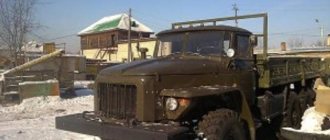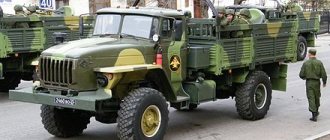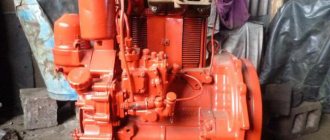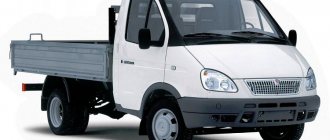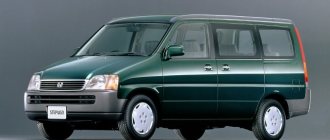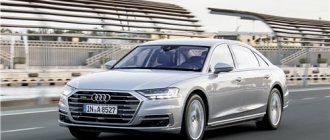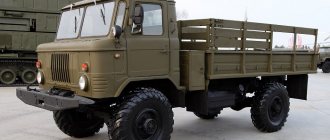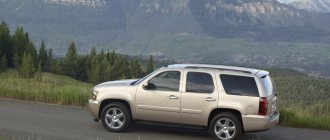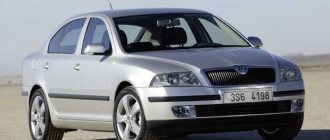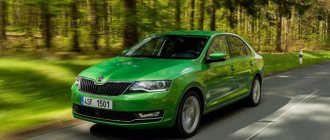Total information
German military all-wheel drive motorcycles gave rise to the spread of such equipment in the USSR in the days after the Great Patriotic War. The Soviet M-72 motorcycle was created for exclusively military purposes, and the Ural series, which still pleases many people with new models, became its continuation.
Initially, motor vehicles became most widespread in rural areas due to accessibility, convenience and reliability. Over time, especially when new Urals began to be equipped with imported parts and were stylized according to current realities, they began to be used in tourism, by bikers, and for simple highway driving.
A large amount of equipment is sent for export. In Europe, no matter what, modern models are highly valued, and some representatives of the series are even intended only for sale abroad.
Specifications
Let's do a full analysis of technical data based on one of the first models - Ural M-62.
Ural M-62
The heavy Soviet motorcycle was equipped with a four-stroke carburetor two-cylinder engine with opposed cylinders and air cooling:
- working volume – 649 cubic meters. cm;
- cylinder diameter – 78 mm;
- piston stroke – 78 mm;
- compression ratio – 6.2;
- maximum power – 28 hp. s., 20.6 kW;
- crankshaft rotation speed at maximum power – 5,000-5,200 rpm;
- maximum torque – 47 Nm;
- carburetor - K-38;
- air cleaner – combined inertial contact-oil filter with two-stage cleaning.
Transmission:
- clutch: dry double-disc, driven discs with linings on both sides;
- cardan transmission: cardan shaft with an elastic coupling and a hinge on needle bearings;
- main gear: a pair of bevel wheels with spiral teeth, gear ratio - 4.62;
- gearbox: four-speed, with gear ratios in 1st, 2nd, 3rd, 4th gears 3.6, 2.28, 1.7, 1.3, respectively.
Electrical equipment:
- ignition system - battery;
- voltage – 6 V;
- battery – ZMT-12;
- generator – G-414;
- relay-regulator – PP-31;
- breaker-distributor – PM05;
- ignition coil - B201.
Chassis:
- frame – tubular double closed type;
- Front wheel suspension – telescopic fork with double-acting hydraulic shock absorbers;
- rear wheel suspension – spring;
- front wheel travel – 80 mm;
- rear wheel travel – 60 mm;
- tire size - 3.75-19 inches;
- brakes are shoe brakes, with friction linings on the front and rear wheels.
Refueling volumes:
- fuel tank – 22 l;
- engine crankcase – 2 l;
- gearbox housing – 0.8 l;
- final drive housing – 0.15 l;
- air purifier – 0.2 l.
Dimensions:
- length – 2,420 mm;
- width – 1,650 mm;
- height – 1,100 mm;
- motorcycle base – 1,100 mm;
- ground clearance at full load and normal tire pressure – 125 mm;
- track – 1,130 mm;
- maximum speed – 95 km/h;
- weight – 340 kg;
- maximum load – 255 kg;
- average operating fuel consumption per 100 km when driving in various road conditions with variable load is 6 liters.
One carburetor for a Ural motorcycle
Among the frequently encountered options for tuning a Ural motorcycle, it is worth noting the installation of one carburetor in the Ural, usually a car one. This is done primarily to reduce fuel consumption. After all, it is well known that boxer engines with original carburetors have a considerable appetite (6-9 liters per 100 km).
In addition, due to the design features of single-chamber float-type carburetors, Ural motorcycles have a noticeable dip during sharp acceleration from a standstill. For some this is unacceptable. Improving the dynamic characteristics of a motorcycle is another reason why such carburetors are installed.
To install one carburetor in the Urals, you need to make so-called “pants” - inlet pipes for each cylinder with a common flange for attaching the carburetor. Since car carburetors are located (longitudinally) in the center of the engine (where the air filter was), the pipes must have strictly the same length and a smooth surface inside, without burrs or steps.
If the carburetor is installed transversely, then the right (left) pipe must be made shorter so that the first channel of the diffuser is exactly in the middle. This way we will ensure equal supply of fuel to the cylinders. The air filter is installed above the carburetor or, if there is not enough space, to the side of it.
Another important point. The intake manifold does not have to be one piece. It must have at least one elastic connection. The motor has a certain thermal expansion. Since the motor is quite wide, this expansion is enough for the connections to the heads to break the tightness of the connection and begin to suck in air. The solution is tritely simple, an incision is made in any convenient place and connected with a rubber pipe.
So, the first car carburetor for the Ural motorcycle is the DAAZ 1111 (1113) from Oka. It is designed for a similar volume - 650 cubic cm. But before installation, it will be necessary to replace the standard jets in the first chamber with 90, and in the second with 92.5. The air channels remain the same.
The K-133 carburetor from Zaporozhets is installed in a similar way. Owners note a noticeable reduction in fuel consumption (3-5 liters per 100 km) compared to two carburetors. The downsides of this carburetor are its dated single-barrel design and workmanship. Today on the market there are more advanced 5-system carburetors with suction, accelerator pump, etc.
One of these is the DAAZ-2108–1107010 carburetor. It is initially configured for a 1.5 liter V8 engine. Before installation on a motorcycle, you will need to select the appropriate jets.
The filter for the carburetors described above is made independently. They make a platform for the filter element, and cover it with a decorative cover on top. They also make an adapter for a standard filter box, if there is enough space for it.
The best models - their features and technical characteristics
Ural ST
Ural City Ti (ST) is a modern model, but as practical as any classic motorcycle with sidecar that can be used every day. It is best suited for people who are encountering this type of technology for the first time and are just learning to drive a motorcycle with a sidecar. Fast cornering and simplified handling of the bike were achieved thanks to the lightweight, low position of the sidecar and reduced ground clearance due to 18-inch wheels.
The engine on all modern models remains quadruple with a displacement of 749 cc. see. Among the differences are:
- 4 valves;
- power system – electronic fuel injection EFI;
- power – 41 l. pp., which is 1 unit higher than other models today;
- torque – 57 Nm at 4,300 rpm.
Transmission:
- clutch – dry double-disc;
- gearbox – mechanical with reverse;
- number of gears – 4;
- drive – cardan.
Chassis:
- frame – tubular steel;
- front suspension – lever, with two spring-hydraulic shock absorbers, spring preload can be adjusted;
- rear suspension - pendulum with two Sachs shock absorbers, 5-stage spring preload adjustment (stroller - monoshock absorber with 5-stage spring preload adjustment);
- front brakes - single floating disc with 4-piston Brembo caliper;
- disc diameter - 295 mm;
- rear brakes: for the rear wheel itself - one floating disc with a diameter of 256 mm with a 2-piston Brembo caliper, for the sidecar wheel - one floating disc with a diameter of 245 mm with a 2-piston Brembo caliper;
- the diameter of the spoked wheels is 18 inches;
- tires – 4 x 18;
- maximum speed – 113 km/h;
- fuel consumption – 7.6 l/100 km.
Dimensions:
- length – 2,327 mm;
- width – 1,615 mm;
- height – 1,367 mm;
- saddle height – 787;
- ground clearance - 165 mm;
- dry weight – 318 kg.
Ural Tourist
The reliable and time-tested Tourist model combines all the best qualities of its predecessors. In addition to domestic parts, it is based on many imported components such as DENSO, Sachs, which gives the bike excellent performance.
For the first time in the series, it was equipped with a lever front fork.
Engine:
- cylinders – two, arranged oppositely;
- no valves;
- power supply system - two Keihin L 22 AA, 32 mm carburetors (remained unchanged for all subsequent models of Ural motorcycles);
- power – 40 l. With.;
- torque – 52 Nm at 4,600 rpm;
- ignition system – electronic CDI;
- starting system – electric and kick starter.
Transmission:
- clutch – double-disc with reverse gear;
- gearbox – mechanical, 4 gears in total;
- drive – cardan.
Chassis:
- front and rear suspension – Sachs hydraulic shock absorbers;
- front brakes - single disc with Brembo floating caliper;
- rear brakes - drum;
- disc diameter – 19 inches;
- wheels – spoked, painted;
- maximum speed – 95 km/h;
- fuel consumption – 8 l/100 km.
Dimensions:
- length – 2,580 mm;
- width – 1,700 mm;
- height – 1,100 mm;
- seat height – 785 mm;
- ground clearance - 150 mm;
- dry weight – 335 kg;
- Fuel tank volume – 19 l.
Ural Patrol
The Patrol model can be safely called a station wagon, which can easily cover distances both on the highway and off-road, regardless of the season. The basis for it was the Ural Tourist.
An efficient all-wheel drive system is the main feature of this model. Just one move - and you have activated the additional drive of the motorcycle sidecar. The distinctive features of the motorcycle include its increased cross-country ability.
In terms of technical characteristics, in addition to the features highlighted above, the Ural Tourist is completely identical.
Ural Gear-Up
Another motorcycle based on the Tourist. It is a militarized model of a modern road motorcycle. Distinctive features of Gear-Up:
- modified coloring, made in military style;
- increased weight, higher maximum load, reaching 612 kg;
- all-wheel drive, which allows, if necessary, to turn on and off the motorcycle sidecar drive using a special lever.
The technical characteristics of the Gear Up model, not taking into account all-wheel drive and increased weight, correspond to the Tourist, which became its prototype.
Ural Retro
The Retro model is stylized to resemble motorcycles of yesteryear, especially appealing to antique lovers. Particular attention is paid to the stylized gear shift knob on the gas tank.
Engine:
- four-stroke;
- volume – 749 cubic meters. cm;
- cylinders – two, arranged oppositely;
- no valves;
- power supply system – 2 carburetors Keihin L 22 AA, 32 mm;
- power – 40 l. With.;
- torque – 52 Nm at 4,600 rpm;
- ignition system – electronic CDI;
- starting system – electric and kick starter.
Transmission:
- clutch – double-disc with reverse gear;
- gearbox – mechanical, total gears – 4;
- drive – cardan.
Chassis:
- front suspension – Marzhocchi telescopic fork;
- rear suspension – Sachs hydraulic shock absorbers;
- front brakes - single disc with four-piston Brembo caliper;
- rear brakes - drum;
- maximum speed – 105 km/h;
- fuel consumption – 8 l/100 km.
Dimensions:
- length – 2,224 mm;
- width – 1,630 mm;
- height – 1,020 mm;
- saddle height – 750 mm;
- ground clearance - 125 mm;
- dry weight – 325 kg;
- fuel tank volume – 22 l.
Ural Wolf
The wolf is made in the style of an American chopper, and members of the Night Wolves biker club took part in its development. The model differs from other Ural motorcycles:
- Extended base.
- Excellent acceleration dynamics.
- High maximum speed – up to 150 km/h.
- A modern look that ensures good demand.
Engine:
- four-stroke with a volume of 749 cc. cm;
- cylinders – 2, arranged oppositely;
- number of valves – 4;
- power supply system – two Keihin L 22 AA, 32 mm carburetors;
- power – 40 l. With.;
- torque – 52 Nm at 4,000 rpm;
- ignition system – electronic CDI;
- starting system – electric and kick starter.
Transmission:
- clutch – double-disc with reverse gear;
- gearbox – mechanical, 4 gears in total;
- drive – cardan.
Chassis:
- steel frame;
- front suspension – telescopic fork;
- rear suspension – pendulum with two hydraulic shock absorbers, adjustable;
- front and rear brakes - one disc;
- maximum speed – 150 km/h;
- fuel consumption – 6.5 l/100 km.
Dimensions:
- length – 2,530 mm;
- width – 850 mm;
- height – 1,300 mm;
- seat height – 650 mm;
- ground clearance - 115 mm;
- dry weight – 249 kg;
- total weight – 430 kg;
- Fuel tank volume – 19 l.
Ural Solo
Solo is a single road bike, created on the basis of IMZ-8.103-10. Unlike most of the models discussed in the article, the motorcycle is designed for highway driving. The solo has a memorable appearance - it is stylized to resemble the technique of the mid-20th century. It’s hard to ignore the gas tank and safety arches, which will not leave indifferent fans of such bikes and riding in general.
Engine:
- four-stroke with a volume of 745 cc. cm;
- cylinders – two, arranged oppositely, total number – 2;
- number of valves – 4;
- power supply system – two Keihin L 22 AA, 32 mm carburetors;
- power – 40 l. With.;
- torque – 38 Nm at 4,500 rpm;
- ignition system – electronic CDI;
- starting system – electric and kick starter.
Transmission:
- clutch – double disc;
- gearbox – mechanical, number of gears – 4;
- drive – cardan.
Chassis:
- front suspension – Marzhocchi telescopic fork;
- rear suspension – Sachs hydraulic shock absorbers;
- front brakes - single disc with four-piston Brembo caliper;
- rear brakes - single disc with Brembo caliper;
- disc diameter – 18 inches;
- maximum speed – 150 km/h;
- fuel consumption – 5 l/100 km.
Dimensions:
- length – 2,159 mm;
- width – 780 mm;
- height – 1,079 mm;
- seat height – 770 mm;
- ground clearance - 125 mm;
- dry weight – 200 kg;
- Fuel tank volume – 19 l.
Ural Sportsman
The Sportsman is a sporty version of an all-wheel drive bike, aimed at a younger target audience. This model is equipped with a switchable wheel drive on the side stroller, a roll bar, a large rear trunk and a windshield that protects from wind and oncoming splashes.
Engine:
- four-stroke, volume - 749 cubic meters. cm;
- cylinders – two, arrangement – opposite;
- no valves;
- power supply system – two Keihin L 22 AA, 32 mm carburetors;
- power – 40 l. With.;
- torque – 52 Nm at 4,000 rpm.
Transmission:
- clutch – double-disc with reverse gear;
- gearbox – mechanical, number of gears – 4;
- drive – cardan, wheel drive.
Chassis:
- front and rear suspension – hydraulic shock absorbers, adjustable in 5 positions;
- front brakes - single disc with Brembo floating caliper;
- rear brakes - drum;
- disc diameter – 19 inches;
- maximum speed – 100 km/h;
- fuel consumption – 7.5 l/100 km.
Dimensions:
- length – 2,580 mm;
- width – 1,700 mm;
- height – 1,100 mm;
- seat height – 790 mm;
- dry weight – 350 kg;
- total weight – 610 kg;
- Fuel tank volume – 19 l.
Ural Ranger
In 2015, Ural presented a new development - the Ural Ranger, which perfectly combines a scrambler and a sidecar. The characteristic features of the new model are:
- Gorgeous design - painted in gray and yellow colors, made in a modern style, the motorcycle clearly stands out among other bikes of the company.
- Off-road tires Heidenau K37.
- LED fog lights.
- High exhaust system 2 in 2.
- Powerful bumpers.
- A steering wheel with a transverse tube on which you can mount a smartphone, navigator or camera.
At the moment, Ranger is only available in European countries. His fate in the vast expanses of the CIS countries is unknown.
Otherwise, in terms of technical characteristics, including dimensions, this model corresponds to the Ural Sportsman.
How can you reduce fuel consumption in the Urals or Dnieper
Every owner of his favorite motorcycle always wants to somehow improve and improve it. As a rule, the most difficult modifications concern the technical part of the motorcycle. And the number of modifications to our motorcycles, including heavy wheelchairs, is simply enormous, ranging from correcting factory defects to improving performance by installing new hardware. It is the second point that I would like to talk about today.
In general, everyone’s approach to this issue is completely different, since someone may not attach importance to the consumption of their motorcycle, considering the figure acceptable, while some, on the contrary, consider the consumption to be prohibitively high, not within any framework. The entire power system for a wheelchair user is generally banal and simple, and in order to improve something in it, you don’t need to be a mechanic with a huge amount of knowledge.
The path of the fuel-air mixture begins with the intake of air, which naturally undergoes some cleaning in the air filter; as a rule, it is most often made of paper or oil with a fiber filler; foam rubber is also found on foreign motorcycles. It is worth excluding zero-resistance filters, which provide a slight increase in power, but increase consumption. It is also logical to remove all possible leaks so that the air path from the air intake to the carburetor is sealed. The air must be clean and not interfere with the flow of air, so you should pay attention to the cleanliness of the filter element. It is also not uncommon for air to cause a “rich” fuel-air mixture.
Well, the key thing is carburetors. I’ll start right away with the fact that carburetors below the K-68 series have a priori not low fuel consumption, this is confirmed by the carburetor manufacturer itself, and in practice it is also noticeable, the consumption of the K-68 is 10-15% lower, this is justified by its technological solutions in the form of an oval an intake window, a new round-shaped damper, a shorter needle, and some other little things. It would seem that everything is banally simple, but K-68 is not the height of perfection. They also require good configuration, we will not touch on this, since this issue has already been raised on almost every forum and more than once. It is also worth paying attention to the synchronization of the carburetors, namely the level of lifting of the dampers, which also significantly affects consumption. Eliminate leaks between the carburetor and the cylinder head. Installing K-68 may not give the desired effect during installation; in this case, it is worth paying attention to the condition of the CPG as a whole, since a worn CPG will literally “devour” fuel and give minimal output.
An even more exotic option is Chinese PKW carburetors, which are more complex to set up but even more efficient. If we talk about numbers, then the consumption can be around 4.5 liters on a single vehicle, this has been confirmed by many testers. The Javanese “Yokov” has approximately the same characteristics. But in any case, you will noticeably lose traction on bad sections of the road when you need good torque at the bottom.
Ignition also plays an important role in this matter. It should definitely not be late, attention should be paid to this, and it is especially recommended to install electronic, relatively inexpensive “tuning” but very effective, due to high-quality sparking, better combustion of the mixture occurs.
Thank you for your attention, friends, what do you recommend to owners of heavy motorcycles to reduce consumption? Write your opinion in the comments. I also recommend reading the following articles:
Source
